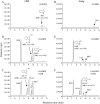Respective roles of CYP2A5 and CYP2F2 in the bioactivation of 3-methylindole in mouse olfactory mucosa and lung: studies using Cyp2a5-null and Cyp2f2-null mouse models
- PMID: 22228748
- PMCID: PMC3310420
- DOI: 10.1124/dmd.111.044081
Respective roles of CYP2A5 and CYP2F2 in the bioactivation of 3-methylindole in mouse olfactory mucosa and lung: studies using Cyp2a5-null and Cyp2f2-null mouse models
Abstract
The aim of this study was to determine whether mouse CYP2A5 and CYP2F2 play critical roles in the bioactivation of 3-methylindole (3MI), a tissue-selective toxicant, in the target tissues, the nasal olfactory mucosa (OM) and lung. Five metabolites of 3MI were identified in NADPH- and GSH-fortified microsomal reactions, including 3-glutathionyl-S-methylindole (GS-A1), 3-methyl-2-glutathionyl-S-indole (GS-A2), 3-hydroxy-3-methyleneindolenine (HMI), indole-3-carbinol (I-3-C), and 3-methyloxindole (MOI). The metabolite profiles and enzyme kinetics of the reactions were compared between OM and lung, and among wild-type, Cyp2a5-null, and Cyp2f2-null mice. In lung reactions, GS-A1, GS-A2, and HMI were detected as major products, and I-3-C and MOI, as minor metabolites. In OM reactions, all five metabolites were detected in ample amounts. The loss of CYP2F2 affected formation of all 3MI metabolites in the lung and formation of HMI, GS-A1, and GS-A2 in the OM. In contrast, loss of CYP2A5 did not affect formation of 3MI metabolites in the lung but caused substantial decreases in I-3-C and MOI formation in the OM. Thus, whereas CYP2F2 plays a critical role in the 3MI metabolism in the lung, both CYP2A5 and CYP2F2 play important roles in 3MI metabolism in the OM. Furthermore, the fate of the reactive metabolites produced by the two enzymes through common dehydrogenation and epoxidation pathways seemed to differ with CYP2A5 supporting direct conversion to stable metabolites and CYP2F2 supporting further formation of reactive iminium ions. These results provide the basis for understanding the respective roles of CYP2A5 and CYP2F2 in 3MI's toxicity in the respiratory tract.
Figures


Similar articles
-
Essential role of the cytochrome P450 enzyme CYP2A5 in olfactory mucosal toxicity of naphthalene.Drug Metab Dispos. 2014 Jan;42(1):23-7. doi: 10.1124/dmd.113.054429. Epub 2013 Oct 8. Drug Metab Dispos. 2014. PMID: 24104196 Free PMC article.
-
The pneumotoxin 3-methylindole is a substrate and a mechanism-based inactivator of CYP2A13, a human cytochrome P450 enzyme preferentially expressed in the respiratory tract.Drug Metab Dispos. 2009 Oct;37(10):2018-27. doi: 10.1124/dmd.109.027300. Epub 2009 Jul 16. Drug Metab Dispos. 2009. PMID: 19608696 Free PMC article.
-
Purification and characterization of heterologously expressed mouse CYP2A5 and CYP2G1: role in metabolic activation of acetaminophen and 2,6-dichlorobenzonitrile in mouse olfactory mucosal microsomes.J Pharmacol Exp Ther. 1998 Jun;285(3):1287-95. J Pharmacol Exp Ther. 1998. PMID: 9618435
-
Metabolism and bioactivation of 3-methylindole by Clara cells, alveolar macrophages, and subcellular fractions from rabbit lungs.Toxicol Appl Pharmacol. 1993 Oct;122(2):182-90. doi: 10.1006/taap.1993.1186. Toxicol Appl Pharmacol. 1993. PMID: 8212000
-
The metabolic basis of 3-methylindole-induced pneumotoxicity.Pharmacol Ther. 1990;46(1):105-18. doi: 10.1016/0163-7258(90)90038-4. Pharmacol Ther. 1990. PMID: 2181487 Review.
Cited by
-
Generation and characterization of a novel CYP2A13--transgenic mouse model.Drug Metab Dispos. 2014 Aug;42(8):1341-8. doi: 10.1124/dmd.114.059188. Epub 2014 Jun 6. Drug Metab Dispos. 2014. PMID: 24907355 Free PMC article.
-
Generation and characterization of a Cyp4b1 null mouse and the role of CYP4B1 in the activation and toxicity of Ipomeanol.Toxicol Sci. 2013 Aug;134(2):243-50. doi: 10.1093/toxsci/kft123. Epub 2013 Jun 7. Toxicol Sci. 2013. PMID: 23748241 Free PMC article.
-
Analyzing the metabolic fate of oral administration drugs: A review and state-of-the-art roadmap.Front Pharmacol. 2022 Oct 7;13:962718. doi: 10.3389/fphar.2022.962718. eCollection 2022. Front Pharmacol. 2022. PMID: 36278150 Free PMC article. Review.
-
Generation and characterization of a novel Cyp2a(4/5)bgs-null mouse model.Drug Metab Dispos. 2013 Jan;41(1):132-40. doi: 10.1124/dmd.112.048736. Epub 2012 Oct 16. Drug Metab Dispos. 2013. PMID: 23073733 Free PMC article.
-
Post-ingestion conversion of dietary indoles into anticancer agents.Natl Sci Rev. 2021 Aug 13;9(4):nwab144. doi: 10.1093/nsr/nwab144. eCollection 2022 Apr. Natl Sci Rev. 2021. PMID: 35505660 Free PMC article.
References
-
- Baldwin RM, Jewell WT, Fanucchi MV, Plopper CG, Buckpitt AR. (2004) Comparison of pulmonary/nasal CYP2F expression levels in rodents and rhesus macaque. J Pharmacol Exp Ther 309:127–136 - PubMed
-
- D'Agostino J, Zhuo X, Shadid M, Morgan DG, Zhang X, Humphreys WG, Shu YZ, Yost GS, Ding X. (2009) The pneumotoxin 3-methylindole is a substrate and a mechanism-based inactivator of CYP2A13, a human cytochrome P450 enzyme preferentially expressed in the respiratory tract. Drug Metab Dispos 37:2018–2027 - PMC - PubMed
-
- Gu J, Zhang QY, Genter MB, Lipinskas TW, Negishi M, Nebert DW, Ding X. (1998) Purification and characterization of heterologously expressed mouse CYP2A5 and CYP2G1: role in metabolic activation of acetaminophen and 2,6-dichlorobenzonitrile in mouse olfactory mucosal microsomes. J Pharmacol Exp Ther 285:1287–1295 - PubMed
-
- Lanza DL, Code E, Crespi CL, Gonzalez FJ, Yost GS. (1999) Specific dehydrogenation of 3-methylindole and epoxidation of naphthalene by recombinant human CYP2F1 expressed in lymphoblastoid cells. Drug Metab Dispos 27:798–803 - PubMed
-
- Lanza DL, Yost GS. (2001) Selective dehydrogenation/oxygenation of 3-methylindole by cytochrome p450 enzymes. Drug Metab Dispos 29:950–953 - PubMed
Publication types
MeSH terms
Substances
Grants and funding
LinkOut - more resources
Full Text Sources

